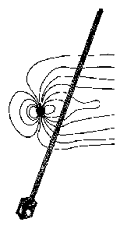Orsted
 Ørsted will be the first Danish satellite. Ørsted carries five science instruments with the objective of mapping the Earth's magnetic field and measuring its associated high-energy charged particle environment. Data from the mission will be used to improve geomagnetic models and study the auroral phenomena, and complements data taken by the Magsat spacecraft in the late 70's-early 80's. The spacecraft is named after the Danish physicist Hans Christian Ørsted who discovered electromagnetism in 1820.
Ørsted will be the first Danish satellite. Ørsted carries five science instruments with the objective of mapping the Earth's magnetic field and measuring its associated high-energy charged particle environment. Data from the mission will be used to improve geomagnetic models and study the auroral phenomena, and complements data taken by the Magsat spacecraft in the late 70's-early 80's. The spacecraft is named after the Danish physicist Hans Christian Ørsted who discovered electromagnetism in 1820.
Spacecraft
Gravity gradient stabilization using the deployable 8 meter instrument boom. Magnetic torque coils maintain yaw to within 10 degrees. Attitude determination via star camera, with Sun sensors and magentometers as backup. 5 body mounted solar panels with GaAs cells provide 54 watts average power (EOL). NiCd batteries provide power in eclipse. Position determination is provided with GPS receivers: a single-band 6-channel TANS receiver from Trimble, and a dual-band 8-channel GPS TurboRogue from JPL, with a resolution of 50 meters or better. Command and control is provided by two 80C186 processors. On-board storage of 13 hours of science data. S-Band communications with a maximum data rate of 256 kbps using cross-dipole antennas.
Payload
Overhauser proton-precession magnetometer measures the scalar values of the magnetic field with a resolution of < 1 nT. CSC fluxgate magnetometer measures the vector values of the magnetic field with a resolution of < 3-5 nT. Particle detectors (6) measure high-energy charged particles: electrons (30 KeV to 1 MeV), protons (200 KeV to 30 MeV), and alpha-particles (1 to 100 MeV). Star Imager determines the absolute attitude of the CSC fluxgate magnetometer with a resolution of < 20 arc-seconds. GPS TurboRogue dual frequency receiver, with a position accuracy of
5-10 cm, for occultation measurements to determine temperature and electron density
properties. The two magnetometers and the star imager are placed on an 8 meter deployable boom. The particle detectors and the GPS TurboRogue are mounted on
the main spacecraft.
| Country of Origin | Denmark |
| Customer/User | Danish Government (ministries of Industry, of Research, and of Transportation) |
| Manufacturer(s) | Computer Resources International, Danish Meteorological Institute |
| Size | Bus: 34 x 45 x 70 cm, Boom: 8 m |
| Launch | Planned for March 1997 as secondary payload on Delta 2 from WTR |
| Orbit | 450 x 850 km, elliptical, polar |
| Design Life | 1 year (3 year goal) |
Information in The Mission and Spacecraft Library is provided without warranty or guarantee. USE AT YOUR OWN RISK.